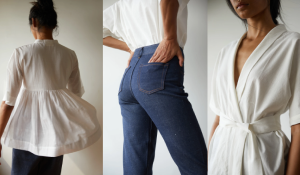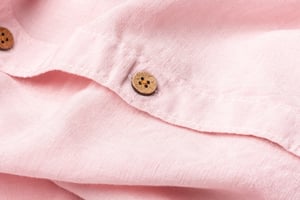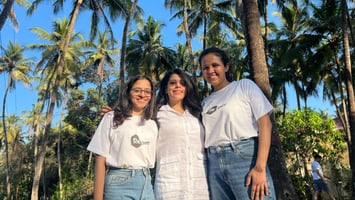I believe brands cannot be 100% sustainable, but products can be. Sustainable fashion is a category...
A Quick Guide To Sustainable Fabrics - Interview 2
Sonal and I met at a Harvard Business School Workshop at the Entrepreneurship Development Institute in Ahmedabad in 2017. Some of the finest CEOs of craft were selected to be a part of the workshop, it was a fine bunch of very impactful fashion founders. Sonal happened to be my roommate for the workshop and so our discussion on fabrics extended beyond small talk.
For a bedtime story, she told me something I have reused over and over again. “Skin is the largest organ of our body and so chemicals in the fabric we wear are being absorbed by the largest organ, imagine what that can do to us” I have never forgotten this and its made me change my own buying decisions.
Sonal Jain has been a crusader of sustainable fabrics – organic cotton to be more precise. Over the years, I have sourced several meters of fabric from her and watched her uphold her values while conducting business. Her ventures - Aura Herbal Textiles, Sustainable Earth Foundation and Maayu (a new sustainable organic underwear brand) highlight that despite challenges, switching to sustainable fabrics can be commercially feasible.
Kirti: Sonal tell me what really motivated you to work in sustainable fabrics?
Sonal: When I started, the fashion industry was not under any kind of scrutiny with respect to the environmental impact of its business practices. Sustainable fabrics was not even a term.
I was in Ahmedabad at the time, a hub of textiles, textile wastewater was being dumped into the rivers and fish were dying. At that time, I did a painting workshop where we were using flowers to make colours. We were painting small pieces of fabric and I thought how about trying these on larger pieces of fabric? I soon learnt that this was how textiles were dyed 60-70 years ago and it blew my mind. I never wanted to be in the fashion and textile industry, I started to help the environment.
Kirti: What was your first commercial attempt?
Sonal: I spent a lot of initial years experimenting and building my know-how about making natural fabrics. I met artisans who were adept at making natural fabrics using natural dyes but even they were moving to synthetic colours. I started dying fabrics at home and testing how they looked, how they could be washed, and other practical aspects. My first commercial attempt was a small pop up where we sold these fabrics. We then set up a small boutique and spread the word among family members and friends. Soon a friend of mine who was studying fashion at NID spoke to people in her department. They were fascinated and invited us to showcase at NID.
Kirti: I know your focus has been on organic cotton, I find it to be most commercially viable and hence its also used by many large brands . I want to know your journey working with it.
Sonal: I first started working with khadi, but it was difficult as there were no standards and there was no regular supply that I could count on. Around the same time, many international visitors showed interest in what we were doing. From them I discovered that organic cotton was gaining popularity in the US.
We researched a lot to find manufacturers of organic cotton. We found one but they were converting it into garments and selling all of it to the US and European markets. We asked if we could buy the fabric and they told us that we would have to buy at least 1000 meters. It was not feasible and so I decided that we would buy and dye the organic yarn and then weave it into fabric ourselves. That’s when my association with handloom weaving also began.
Soon we started getting international inquiries but they demanded we use GOTS-certified organic cotton. We couldn’t get the certification done because it had to be machine-made cotton made in a certain environment and it was a very expensive process. Even today, handwoven organic cotton does not have certifications only machine made ones do.
Kirti: What has changed about working with organic cotton then and now?
Sonal: Not much has changed, unfortunately. You still need to buy in bulk. I have tried to look for alternatives. One of them being indigenous cotton which is better than organic cotton because it doesn’t require a lot of water, and indigenous seeds are used which benefits the farmers. Indigenous organic cotton is not made with machines and factories, hence this too cannot be certified.
We wanted to work with farmers and that is also one of the main reasons why we continued working with organic cotton. Organic cotton supports the well-being of farmers in a large way. It takes a while to scale but on the positive side, global demand for organic cotton is growing. We are trying to figure out how we can standardize that and how we can get certifications for handwoven organic cotton.
Kirti: While you are talking about farmers and the environment, I would say customers have a selfish reason for choosing organic cotton. They don’t just think about the environmental impact, they understand that its better for their skin and body too. Making it more widely in demand. Have you observed this trend?
Sonal: The values of our company focus on health and well-being - the health and well-being of the user, the makers, and the environment. Organic cotton helps all three. The method is safer as the farmer does not have to douse the crops in synthetic pesticides. To give you context, a synthetic pesticide is much stronger than the rat poison that you have in your house. These pesticides can make way to your table because farmers grow other crops too along with cotton.
It is also worth mentioning that pesticides remain on your clothes and synthetic dyes add to the problem. If the cotton is grown synthetically without much consideration for toxic chemicals, chances are that little attention has been paid to the dyeing processes too. All this comes directly into contact with your skin.
Kirti: What is your opinion on using organic cotton and synthetic dyes?
Sonal: Its pointless, because while you eliminate pesticides, many more toxic chemicals are used for processing the textile. If you pick up a T-shirt, it has 8,000 to 12,000 chemicals on it and if the fabric has labels like stain-free, and odour-free, then the number goes up to 24,000 and the dying also destroys 2,000 liters of drinking water.
Kirti: Would you say zero dye organic cotton is the most sustainable fabric?
Sonal: Zero dye, zero bleach, organic cotton, handwoven, handmade is the most sustainable. As far as dyes are concerned, natural dyes are the safest dyes but keep in mind there are also a lot of natural colours that can be harmful to the users and the environment.
Kirti: Which colour is the best?
Sonal: Natural dyes have always held a special place in our traditions. The beauty of natural dyes lies in the fact that they were used never just for the colour but always for enhancing our well-being. So if you look at all our cultural activities, whether it's Holi or Diwali, there is a very strong element of yellow that is always used. Haldi has been used extensively for ages - our mothers would use haldi, haldi would be put on infants and newlywed couples, etc. That was how colours were instituted in our lives but the whole language about colour has become completely different now.
Kirti: What could be an alternative that we can propose to very large companies that cannot use natural dyes?
Sonal: According to me there should be no such compromise, they must attempt natural dyes. Of course, there are GOTS-certified dyes that are being sold in the market and which are also called low-impact dyes but it is not that they have no impact at all. All synthetic colours are carcinogenic. They impact your health on multiple levels. In terms of the commercial aspects and the scale, there are many challenges. If everybody makes that switch, I don’t think it won’t be scalable. We have to reassess the way we are approaching it.
Kirti: Have you tried any fabrics other than organic cotton what would be those fabrics and what would be your opinion on them?
Sonal: On an experimental level you can say we have tried everything that has been around – from polyester to modal to silk because in order to assess whether they are sustainable or not we had to explore to a certain extent. One of the most sustainable fabrics other than organic cotton is linen. There are many advantages of using linen such as linen regenerates the land it is grown on but unfortunately, awareness in India is scant. All the linen is imported from other countries whether it is in the fabric form or yarn form and importing increases the carbon footprint significantly.
Kirti: What about hemp?
Sonal: Experiments are being done to grow more hemp in India but it is very coarse and not suitable for clothing purposes. Hemp is a beautiful fabric but it is hard to find high-quality linen or hemp in India and it is expensive too.
Kirti: What is your opinion on lyocell?
Sonal: All of these are made from tree fibers. It is a very energy-intensive process as the tree material is very hard and a lot of synthetic ingredients have to be used to make it into a wearable softer fiber. We are not comfortable working with it.
Kirti: What is your opinion on innovative fabrics like milk fabric, and orange fabric?
Sonal: We strongly believe that something that gives us nutrition should not be used for garments. We have very clear parameters – it should also not be coming from an animal source.
Kirti: What about bamboo as fabric?
Sonal: Bamboo also comes from a plant fiber and needs a lot of synthetic intervention to be broken down and made into a fabric. Again, it is a very energy-intensive process.
Kirti: Have you tried recycled fabric? Do you think fabric recycling can solve the problem?
Sonal: One of the most popular methods of recycling fabric is by converting PET bottles into fabric. It defeats the purpose because it is plastic at the end of the day. Do you really want to wear plastic? Now converting a PET bottle into fabric requires a lot of energy for it to be broken down. Also, you cannot dye it with natural colours and you will have to use synthetic colours.
Kirti: What I have heard is that fabric recycling is not happening only in India. Is it true that it is basically a myth?
Sonal: It is a myth because it doesn’t make sense. It is more expensive to convert waste materials into fiber and then make garments out of it. This can be called a kind of greenwashing where a handful of companies make claims along the lines of them solving the problem of PET bottles. By doing what? By making people wear garments made of pet bottles that shed microplastics? It is merely a marketing gimmick.
Kirti: Anything else that you would like to share?
Sonal: I would request consumers to be more aware and go a little deeper into the making of the fabrics they wear. Although I started working in this space because I was motivated to do something for the environment, I have realized that humans are more vulnerable than the environment and we are the ones at higher risk.
You are right Sonal, we cannot kill the planet, its way too strong, it will kill us first.
//
Stay tuned for the next interview, next Saturday -- Do visit www.relove.in to subscribe to this blog.
.png?width=1600&height=1080&name=Untitled%20design%20(47).png)



